Ever noticed your dog yelps when barely touched and wondered what's going on? It might seem like they're being dramatic, but there could be more behind that sudden squeal.
Dogs don't just yelp for no reason. Sometimes it's discomfort, sometimes it's fear, and sometimes it's just a really sensitive spot.
Did you know some pups can be extra vocal even if the issue isn't serious? Whether your dog is hurt, scared, or just sensitive, we'll break it all down so you know exactly how to help. Keep reading!
Reasons Why a Dog Yelps When Touched

If your dog yelps when touched, something's definitely up! It could be a quick sting, a deeper issue, or just their nerves talking. Some causes are simple, while others call for medical attention. Let's explore the big three reasons that could explain your dog's dramatic squeak.
Sudden Pain or Injury
A dog yelping when barely touched might be reacting to sudden discomfort. Maybe they got a bump, twist, or even a bug bite. This sharp ouch often triggers a fast pain response. Check for cuts, swelling, or limping. If your dog starts yelping in pain out of nowhere, you might need a vet immediately.
Underlying Health Conditions
If the yelping sticks around, it might be something deeper going on.
-
Joint or muscle problems
-
Neck or back pain
-
Hidden injury or body tenderness
-
Spinal pain or discomfort
-
Medical condition causing aches
These may require diagnostic tests to find the underlying cause. Never ignore ongoing signs, your dog's pain might not be obvious at first.
Sensitivity Due to Anxiety or Fear
Sometimes it's not the body—it's the mind. Dogs with fear or anxious behaviors can react with yelping even when there's no injury. A loud sound, sudden movement, or bad memory can make your dog scared and start yelping. Their body reacts like they're hurt, even when they're just shaken.
Common Causes of Physical Sensitivity in Dogs
If your dog is yelping for no reason, there could be a hidden reason behind it. Physical sensitivity in dogs often ties back to something deeper. Let's sniff out the common causes behind those sudden yelps, squeals, and flinches when barely touched.
Muscle Strain or Joint Soreness
Playtime is all fun until your dog's back legs feel sore. Joint or muscle problems, especially in active breeds, can trigger a pain response even from light pressure. If your dog is yelping when touched after exercise, she's hurting and might need rest, an ice pack, or a visit to the vet immediately.
Skin Irritation or Allergies
Itchy skin? That's enough to make any pup squirm! Rashes, bites, or allergies can turn normal behavior into uncomfortable yelping. A Shih Tzu with skin irritation might yelp when brushed. If your pet flinches from a gentle pat, look for redness, bumps, or signs of discomfort around the body or bed area.
Nerve Issues or Spine Problems
A dog yelping in pain could point to spinal pain or nerve trouble. Touching the neck or back might make them cry or shake. If there's an unusual head posture or they avoid jumping or walking, it could be spinal pain or another underlying cause. Diagnostic tests and veterinary attention are key here.
Ear Infections or Dental Issues
If your dog yelps when touched near the head, ears, or face, ear infections or dental problems might be the culprit. The pain can feel sharp, like a sting, making them react quickly. Look for signs like head shaking, whining, or pulling away when touched on one side of the face.
Insect Bites or Stings
An insect bite can make your dog react like they've been zapped! Swelling, redness, or sudden yelping in pain after outdoor play could point to stings. Touching the affected area might make your dog start yelping. Apply a cold compress and watch closely, sometimes an ice pack is all they need!
Recent Vaccination or Injections
Shots are no fun for anyone, even dogs. If your dog is yelping when barely touched around the shoulders or thighs, a recent injection site may be sore. This can cause mild aches or tenderness for a day or two. A little rest, light movement, and cuddles can help ease the discomfort.
Internal Discomfort
If your dog yelps when you touch her belly, there might be internal issues brewing. Watch for a rock-hard abdomen, shaking, or signs of abdominal pain. This isn't something to guess about; contact your veterinarian for medical attention. Internal discomfort often needs appropriate treatment before things get worse.
Is It Normal If My Dog Yelps When I Touch Them?

A yelp is no big deal. Other times, it's your dog's way of waving a red flag with their tail. Let's break down what's normal and what needs a closer look.
- Temporary Discomfort From Overuse or Strain. A day of running, jumping, or wrestling can leave your dog feeling sore. This kind of discomfort usually fades with rest.
- Ongoing Pain That Doesn't Go Away. If your dog keeps yelping for no obvious reason, it might be chronic pain. Ongoing aches can come from joint or muscle problems or a deeper medical condition.
- Yelping That Starts Suddenly. Acute pain, like from a sudden injury or bug bite, can trigger loud yelps out of nowhere. If this happens, watch their behavior closely.
- Changes in Behavior or Movement. If your pup avoids stairs, stops jumping, or walks funny, something could be wrong. These shifts in normal behavior may need a vet's attention.
- Signs That Worsen Over Time. Pain that ramps up like crying, flinching, or shaking, should never be ignored. Call your veterinarian if the discomfort seems to be getting worse.
Areas Where Dogs Are Most Sensitive to Touch
Some parts of a dog's body are like big red "Do Not Disturb" buttons. Touch them the wrong way, and they might let out a big ol' yelp.
- Ears, Paws, and Belly. These spots are packed with nerve endings. A scratch, sting, or skin irritation in these areas can trigger a quick pain response.
- Joints and Back. Neck or back pain and sore joints can make light pressure feel awful. Touching these areas can set off barking, shaking, or even growling.
- Mouth and Teeth. Dental issues often fly under the radar until your dog yelps. If a touch near the mouth sparks a reaction, dental discomfort might be the culprit.
How to Comfort a Dog That Yelps From Physical Touch

When your dog is yelping in pain, your response matters. A calm, thoughtful approach can go a long way in easing your pup's discomfort. Let's walk through a few easy ways to create comfort while you figure out the next best step.
Create a Calm, Safe Space
First things first—help your dog feel secure. If your dog yelps when barely touched, they may be scared, not just sore. Move them to their bed or a quiet corner. Keep other animals and loud noises away. This helps lower fear, ease anxious behaviors, and stop the stress that can worsen your pet's pain response.
Use CBD for Soothing Discomfort
Sometimes, a little natural support can go a long way. CBD products offer gentle, plant-based support for dogs dealing with joint, muscle, or body soreness.
- CBD Dog Treats + Joint and Mobility Care. Made with turmeric root, Boswellia, and hemp seed powder, these treats support joint structure and help soothe soreness from mobility issues.
- CBD Calming Chews. Ideal for dogs that are scared, sensitive, or prone to anxious behaviors. These peanut butter-soft bites include chamomile and L-tryptophan to settle nerves without causing sleepiness.
- CBD Wellness Dog Treats. These daily treats promote general wellness using blueberries, flax seeds, and sweet potatoes—all packed with antioxidants and calming support.
Avoid Handling Sore Spots
If your dog is yelping in pain, skip the full-body cuddles for now. Avoid touching any area that seems sore, like the neck, belly, or back legs. Gently observe without poking or pressing too hard. If they flinch or cry, it's time to call your vet for appropriate treatment and diagnosis.
Keep Activity Low and Stress-Free
Help your dog rest and recharge with a mellow routine.
-
Short, slow walks around the yard
-
Skip the rough play and long hikes
-
Offer soft bedding for joint or muscle problems
-
Avoid loud sounds that might scare your pet
-
Keep kids and other animals at a distance
A peaceful space can ease shaking, reduce discomfort, and help your dog feel safe again.
When to Take Your Dog to the Vet
Some yelps are harmless. Others? Total red flags. If your dog is yelping in pain, don't wait too long to get help. Here's when you should call the vet immediately:
-
Limping, shaking, or hiding
-
Unusual head posture or stiffness
-
Rock-hard abdomen or belly sensitivity
-
Back legs seem weak or unstable
-
Ongoing yelping with no apparent reason
Vets use physical exams, x-rays, and diagnostic tests to pinpoint discomfort and provide the appropriate treatment.
Final Thoughts – Understanding Why Your Dog Yelps When Touched
A dog that yelps when barely touched isn't just being dramatic—they're trying to tell you something. Whether it's joint or muscle problems, anxiety, or something deeper, tuning into your dog's behavior is key.
Keep an eye on changes, avoid sore spots, and always opt for a trip to the vet if the signs are serious. You can also support your pup daily with HolistaPet CBD treats, calming chews, and wellness products made just for dogs and cats. Gentle care goes a long way!

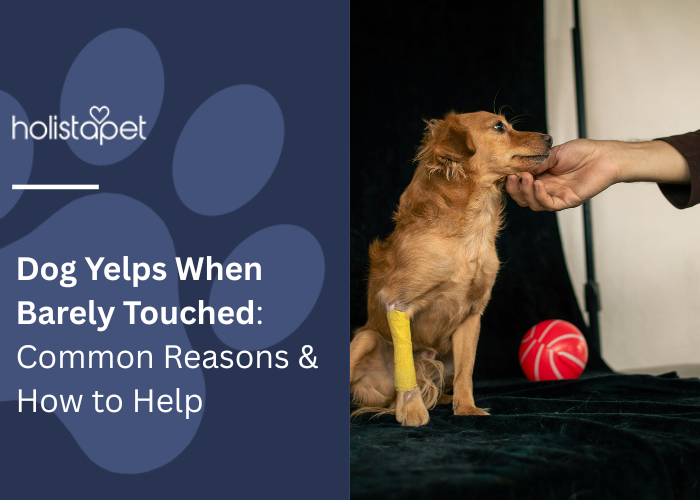
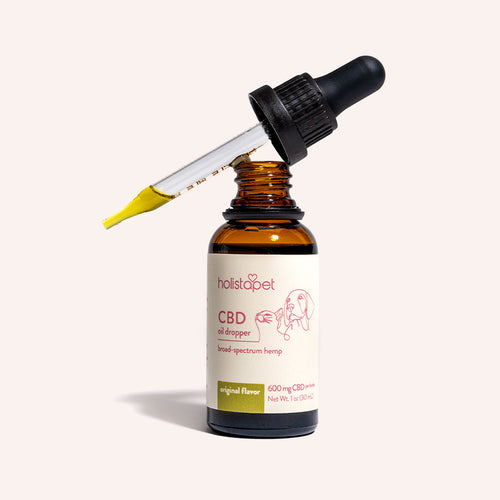 CBD Oil for Dogs - Fast Acting
CBD Oil for Dogs - Fast Acting
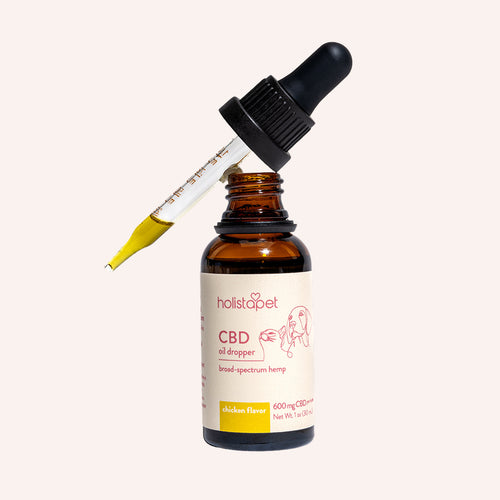 Chicken Flavored CBD Oil For Dogs - Easy Dose
Chicken Flavored CBD Oil For Dogs - Easy Dose
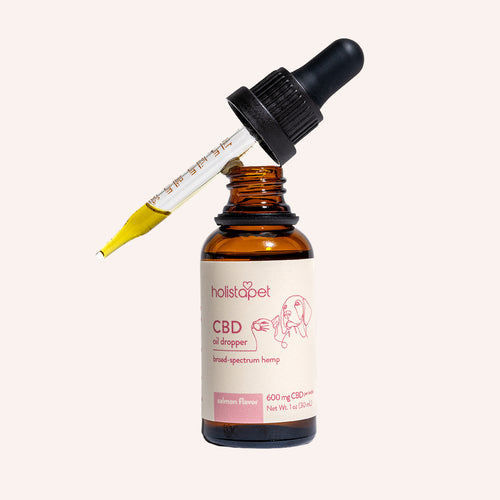 Salmon Flavored CBD Oil For Dogs - Highly Rated
Salmon Flavored CBD Oil For Dogs - Highly Rated
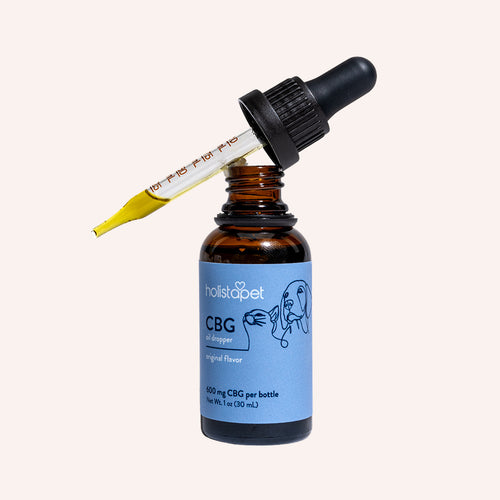 CBG Oil for Dogs and Cats - Loved by Thousands
CBG Oil for Dogs and Cats - Loved by Thousands





Leave a comment
All comments are moderated before being published.
This site is protected by hCaptcha and the hCaptcha Privacy Policy and Terms of Service apply.